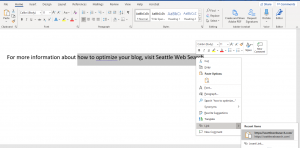Citing sources in your blog is different from citing sources in an academic paper. The good news: you don’t need to know APA or MLA format. All you need are reliable sources and links to them. Knowing how to cite sources for a blog is crucial for creating engaging and informative content that attracts visitors and grows audiences.
Contents
Cite sources from trusted sites on your blog
Before you begin creating content for your blog, be considerate of what sources you’re using. It’s best to use industry experts and proven data and facts as resources for the information you’re writing about.
How do you know if a site is trusted or has a good reputation? See if other sites have cited them as well. Check out their “about page” to view their credentials and experience.

Once you find trusted sites to use as sources for the information you’re putting into your blog, be sure to take note of the links of the pages you’re using. You’ll need them to create hyperlinks by copying the URL and pasting it into the desired text. On most devices, you can highlight the text, right-click (or double tap) the highlight, and then select “insert link” to add the link source to the text.
Consider using your own site as a source for backlinks
To boost your website’s SEO, try using links from other pages on your website as sources. These kinds of links are called backlinks, and they’ll help keep visitors on your site by guiding them around to other information you’ve published. This also increases their interest in your expertise and whatever it is you’re promoting to them.
Be smart and creative about how you incorporate hyperlinks into your blog
Use the links of your sources and add them into the text of your content in a way that doesn’t come off as distracting. You do this by introducing the source, directly or indirectly, then sharing its information and how it connects to what you’re conveying in your blog. Here’s an example:
Seattle Web Search knows that SEO is necessary to rank in Google’s search engine.
According to Yoast, search engine optimization is necessary for ranking in Google’s search engine, which is why Seattle Web Search works to help businesses boost their SEO.
Notice that the hyperlinks flow with the rest of the text and the words that introduce or explain the link source are included in the link. This helps bring the reader’s attention to it without being distracting.
However, be careful with how many words you include with the link: too many, and it will hinder your reader’s attention. Too few words, and the hyperlink may be overlooked. Let’s look at these modified examples:
According to Yoast, search engine optimization is necessary for ranking in Google’s search engine, which is why Seattle Web Search works to help businesses boost their SEO.
The first hyperlink has too much text; it’s distracting. The second example hyperlink is barely noticeable. Find the right balance in the number of words you need to use to link back to your source. You may have to rewrite a few things to do so.
Conclusion
Links are important for your blog: they improve readability and allow you to give credit to your sources, all while showing your readers that the information you’re presenting to them is credible and your expertise can be trusted. These techniques help improve your blog’s SEO. Check out this guide on SEO for blogs for more tips!



